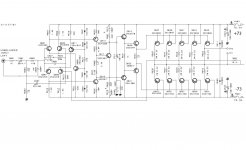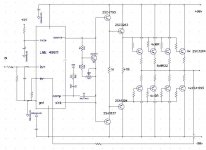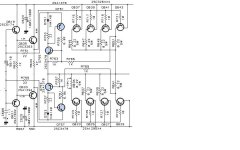This is the basic schematic of the rotel 1080B nice straight forward simple topology operates from 73+73 volts claims 200W @8R and 300@4 ...how about a bit more power with some 10 volt more higher rails may be the same 5 sets of outpouts but 1943-5200 and may be the adition of a vi limmiter
any opinions ????
kind regards sakis
any opinions ????
kind regards sakis
Attachments
Thanks for posting the circuit Sakis, I was curiouis too. It seems from the spec. that the original PSU is weak, like a lot of Hi-fi designs that only rate for 8 ohm power and bragging rights.
Maybe just a larger transformer and minor adjustments for current plus improving a few PCB track, resistor and driver issues are all that's needed to get closer to 400 W output - assuming that is enough for your needs.
You are the man for PA stuff and your avatar says it all for going up in voltage and overall power like Bobo says. FWIW, to me, the design looks 100% Hi-fi and would need safety features as you say and even a redesign for CCSs and LTPs to be optimum, stable and reliable when the amp. works hard into low impedance.
Maybe just a larger transformer and minor adjustments for current plus improving a few PCB track, resistor and driver issues are all that's needed to get closer to 400 W output - assuming that is enough for your needs.
You are the man for PA stuff and your avatar says it all for going up in voltage and overall power like Bobo says. FWIW, to me, the design looks 100% Hi-fi and would need safety features as you say and even a redesign for CCSs and LTPs to be optimum, stable and reliable when the amp. works hard into low impedance.
Ian .... methods like that has been used by many manufacturer so trafo is calculated to be on the edge just enough to meet the specs on a resistive load and then rail voltage to dive down under hard rive or demanding load
this is actually working also as an active limmiter but of course will increase distortions and create other problems if driven hard ...
concept is very simple ....this is supposed to be a quality HIFI amp so its expected to play loud but not pushed the same way as PA amplifier ....
yet again biger models like that 1090 which can provide almost double the power working with rails 96+96 is by far more complicated to clone and also equiped with all te needed goodies such is current sinks and sources and of course sophisticated VI limmiters
regards sakis
this is actually working also as an active limmiter but of course will increase distortions and create other problems if driven hard ...
concept is very simple ....this is supposed to be a quality HIFI amp so its expected to play loud but not pushed the same way as PA amplifier ....
yet again biger models like that 1090 which can provide almost double the power working with rails 96+96 is by far more complicated to clone and also equiped with all te needed goodies such is current sinks and sources and of course sophisticated VI limmiters
regards sakis
Rotel amplifiers where generally fine products , and this one
doesn t make exception.
Dual differential amps are more stable than classic
mono differential ones when supply voltages are
increased.
The compensation networks (560p + 220R) should
work with any BJTs , providing they are as fast as the
original ones.
One slight modification that can increase stability
is to add resistors in the emitters of the differentials
Bjts....47 to 100R should do it, but at the expense
of the THD ratio that would slightly increase...
doesn t make exception.
Dual differential amps are more stable than classic
mono differential ones when supply voltages are
increased.
The compensation networks (560p + 220R) should
work with any BJTs , providing they are as fast as the
original ones.
One slight modification that can increase stability
is to add resistors in the emitters of the differentials
Bjts....47 to 100R should do it, but at the expense
of the THD ratio that would slightly increase...
good to see you WAHAB .... ( did you make any new music ??? ) thanks for advices i will keep them in mind ... will see this is a feature product ....will make a clone and see how it goes
kind regards sakis
Hi, Sakis,
Well, no music these times, i was in my native country
for two months , in mountaineous areas , among olive trees..
Must look a lot like your country as well..
About this amplifier, i must aknowledge that this
is the kind of topology i prefer , and i always had
very good results with it.
No doubt that you ll experience the same satisfactory
functionning with this one.
cheers,
Wahab
Attachments
Hi, Sakis,
Well, no music these times, i was in my native country
for two months , in mountaineous areas , among olive trees..
Very nice place!
Very nice place!
Thank you , DOMTW ,
Yes, this country is incredibly beautifull , another
planet in many ways...
Alike France where i currently live, i suppose that
god did compensate so much gifts by creating
his typical inhabitants !!..
Cheers,
Wahab
Rotel 1080B upgrade
But it sure looks a nice, easy build and great idea for all that power.
Sure, I understand this well enough. Most domestic gear I have had to look at has clearly been built this way. However, VI limiting is often disliked in Hi-fi amps for the claimed distortion effects at medium to high power..... methods like that has been used by many manufacturer so trafo is calculated to be on the edge just enough to meet the specs on a resistive load and then rail voltage to dive down under hard rive or demanding load
But it sure looks a nice, easy build and great idea for all that power.
Please, tell us what you are thinking about for the PCB and details like Trafo, Sakis. Maybe if mono, dual type or what is preferred. I think we are interested as Wahab says about his preference for the design. Maybe it is already built and working in your plans!
ian ...if i produce pcb or work with this design it will be made as a pro amp as i described in the begining .... bit higher, rails bit more rowbust semis , and Vi limiters
pcb will be made with this concept ( as a pro amp ) and so on ......
this is a feature project and producing and testing will take long
will see ...first i need to finish tha QLA amplifier i am working with
I have built an amp copying the RB1090 output stage - which has the same topology as the RB1080- using an LME49810 chip as front end.
The RB1090 -schematic is on the web- incorporates a VI limiter.
bobodioulasso..... the output of the 1080 is the most common arround AB amplifiers ...driving circuit behind it is the all story .....using 49810 your amplifier will have the goods and bads of it and the character fo the spoecific IC
If you look at RB1090 schematic, they have cascoded input stage and vas to wisthand the 95 volts rails.They end with more sophisticated circuits.
I fear you'll have to redisign the whole amp - at least replace all transistors- when increasing the rails voltage + using a stiff supply.
I have choosen the lme solution and have not to complain at the end.
Have you listen to LMEs?
I fear you'll have to redisign the whole amp - at least replace all transistors- when increasing the rails voltage + using a stiff supply.
I have choosen the lme solution and have not to complain at the end.
Have you listen to LMEs?
no ...not yet at least ....generally dont like chips of any kind ...at this case i may "put some water in my wine " as we say in greece ....
the only thing that stoped me so far is that the lme to work at their best need a few volts more than the output to preserve low distortion and clipping behaviour
that alone will increase the cost and complexity of power supply .....
the only thing that stoped me so far is that the lme to work at their best need a few volts more than the output to preserve low distortion and clipping behaviour
that alone will increase the cost and complexity of power supply .....
- Status
- This old topic is closed. If you want to reopen this topic, contact a moderator using the "Report Post" button.
- Home
- Amplifiers
- Solid State
- a...Rotel design



